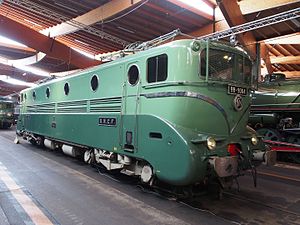railroad.wikisort.org - Train
The SNCF BB 9003 and BB 9004 are French direct current electric locomotives with two trucks each having two driving axles. Built at the same time as SNCF BB 9001–9002, these four units were used to evaluate locomotives with total adhesion in the course of normal operation. They also served as prototypes that helped define the mechanical and electrical characteristics of future locomotives to be ordered in greater quantities.
Operational history
BB 9003 was built and delivered in 1952 and was the first French locomotive to be remote-controlled from the exterior of its train. BB 9004 was built and delivered in 1954 and later broke a rail speed record of 331 km / h on 29 March 1955 on the Landes line between Facture and Morcenx, France,[1] a day after SNCF 7107 did not exceed the actual speed of 325 km / h,[2] but the railway gave the speed record of 331 km / h to the credit of the both machines in order to protect the commercial interests of the manufacturers.[3] The event was widely broadcast in France and in other countries; an American television news crew sent an airplane to overfly the attempt and they were certain the train would derail before reaching 330 km/h. In fact, the airplane had trouble keeping up with the train. SNCF engineers were delighted at the performance; this attempt represented a beginning into the study of using electricity as the means of propulsion for high speed rail.[4]
When leaving the factory, BB 9001 and 9002 wore a two-color livery (dark bluish green and light bluish green) with aluminum stripes down the centerline, similar to the 2D2 9100s released shortly before them. 9001 and 9002 were later repainted in a uniform dark bluish green paint scheme.[5]
BB 9004 ran for only 21 years, being used in revenue service until 1973. After withdrawal from service, it was stored in Hausbergen (near Strasbourg). The unit was sent to the Arles workshops to be restored in 1979 and was donated to the Cite du Train in 1981. In 2005, BB 9004 was run one final time on the Landes line in a special train along with CC 7107 as part of the commemoration of the 50th anniversary of the world speed record.[6]
Design
Both BB 9003 and BB 9004 where electric locomotives using a Bo-Bo wheel configuration (meaning two trucks each with two powered axles). Alongside this both had twin pantographs and were powered by 1.5 kV DC overhead wires.
They differed slightly from one another however, as BB 9003 used four Swiss-built Oerlikon 6F330 traction motors while BB 9004 used four French-built Jeumont-Schneider SW 4326 traction motors. BB 9003 was also lighter at 80 tonnes versus the 83 tonnes of BB 9004. BB 9003 was also more powerful then BB 9004 at 4,260 horsepower versus 4,000 horsepower.
Their Jaquemin-designed trucks were later used in BB 9200-9300-9700, 12000–13000, 16000–16100, 20100, 25100-25150-25200 series locomotives, the body design (with common aesthetics) would be used in BB 9200-9300-9700, 9400, 16000–16100, 20100, 25100-25150-25200, 30000 series locomotives and traction equipment (JH servomotors) would be used in the BB 9200-9300-9700 series.
Preservation
BB 9004 is preserved at Cite du Train, in a livery similar to one worn during the 1955 record winning run. The BB 9004 which is preserved uses the body from BB 9003 while using the frame, running gear and internal components from BB 9004. This was done as the body of 9004 was in too poor of a condition to be preserved.
Image Gallery
- The driving stand of BB 9004
- The builders plate of BB 9004 along with the record plaque
- BB 9004 on display at the Grand Palais in Paris in December 2007
References
- "Untitled". Chemins de Fer (in French). No. 191. March–April 1955.
- Loïc Fieux (February–March 2005). "331 km/h : le mythe est-il réalité ?". Correspondances ferroviaires (in French). No. 17. Retrieved 17 May 2020.
- Raymond Legrand-Lane (March–April 1995). "40 ans après l'exploit... les souvenirs d'un témoin". Voies ferrées (in French). No. 88.
- #UneNuitAuMusée, Facebook Live depuis la Cité du Train #Mulhouse [#A night at the museum, Facebook Live from the Cite du Train #Mulhouse] (facebook live recording) (in French). Mulhouse: Cite du Train. 16 May 2020. Event occurs at 0:33:35. Retrieved 17 May 2020.
- "Sur l'évolution des couleurs des locomotives électriques construites depuis 1945". Loco-Revue (in French). No. 302. January 1970.
- "#CeJourLà #record". Cite du Train instagram (in French). 29 March 1955. Archived from the original on 26 December 2021. Retrieved 30 April 2021.
На других языках
[de] SNCF BB 9003 und 9004
Die SNCF BB 9003 und 9004 waren französische Elektrolokomotiven aus den Jahren 1952 und 1954, die als Testlokomotiven für den Bau einer größeren Serie von vierachsigen Lokomotiven in Drehgestellbauweise gedacht waren. Beide Lokomotiven entstanden gleichzeitig mit den BB 9001 und 9002, im Gegensatz zu diesen waren sie jedoch von französischen Firmen hergestellt worden. Die BB 9004 hat 1955 den Weltrekord auf Schienen mit einer Geschwindigkeit von 331 km/h aufgestellt und ist heute Exponat im Eisenbahnmuseum Mülhausen.- [en] SNCF BB 9003-9004
Другой контент может иметь иную лицензию. Перед использованием материалов сайта WikiSort.org внимательно изучите правила лицензирования конкретных элементов наполнения сайта.
WikiSort.org - проект по пересортировке и дополнению контента Википедии



